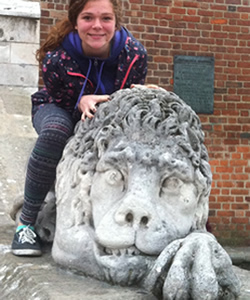A tourist passing through Warsaw and visiting Old Town and the city center will marvel at signs of Westernization, particularly if they are unaware of Poland’s recent growth. Starbucks? The Hard Rock Café? Bubble tea? I know that even I, who has visited Poland before, was shocked to see an Auntie Anne’s nestled in the train station.
Stay a week or two, begin to explore the lesser-known cafés and spots where Varsovians go, and you realize that the Polish culture is still present and strong, despite all the recent commercialization.
Then, as you speak with locals more and settle in to the daily grind of life in Warsaw, you notice that—no matter what—almost everything about Poland today leads right back to its past. And, usually, to World War II.
Visiting Poland, I naturally expected a good dose of history. A trip to Auschwitz, Schindler’s Factory Museum, the Warsaw Uprising Museum, and any other tour is inevitably a lesson in what is probably the most tragic period of this country’s history. A quick visit with Polish relatives also included a reminder of the past as my aunt stood over the stove preparing dinner while re-hashing the night Nazi soldiers knocked on her apartment door and forced her mother and siblings from their home.
Going to the movies, I was surprised by a music video that played before the movie began. The popular rap was about the Polish Underground Movement during the Warsaw Uprising that sought to liberate the city from Nazi occupation during World War II. I struggle to imagine Lil Wayne referencing Vietnam in his lyrics or Drake dedicating a song to the bravery of American soldiers. Yet, even my generation of Poles continues this remembrance of World War II. Perhaps more telling is the graffiti around the city depicting the symbol of the Polish Underground Movements. I can’t even picture American hooligans choosing to vandalize buildings by spray-painting historical symbols of patriotism.
Warsaw, perhaps more than any other city, cannot westernize and modernize itself out of its history. Eighty-four percent of the city was completely destroyed during the war. Bullet holes at chest level are left in the courtyards and on the walls of the buildings that did survive. The debate over who is to blame for the events that unfolded during the Warsaw Uprising continues even today. Even on a city tour, a difference of opinion was clear between our tour guide and program assistant. Neither one is over 30 years old, but the city’s history is a living one that no one can ignore. Were the Poles naïve in trusting that the approaching Soviet troops would come to their aid during those horrific days of the Uprising? Were they putting too much faith in mankind, never expecting Stalin to watch idly by as hundreds of thousands were slaughtered by Nazi troops, thereby easing the way for many decades of communist oppression? Over half a century has passed, but the debate continues.
Poland, particularly in recent years, has been optimistic and hopeful to become closer to the rest of Europe and the EU—a return to the fold that the Poles had never chosen to leave. They may have H&M, vegan coffee shops, and beautiful shopping malls, but beneath it all is a past that Poles continue to either keep alive or are simply unable to be free of.

